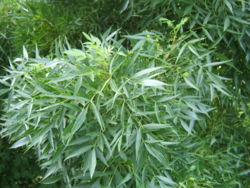Fraxinus angustifolia
| Habit | tree
| |
|---|---|---|
| Height: | ⇕ | 80 ft"ft" can not be assigned to a declared number type with value 80. |
| Width: | ⇔ | 40 ft"ft" can not be assigned to a declared number type with value 40. |
| Lifespan: | ⌛ | perennial |
| Exposure: | ☼ | sun |
|---|---|---|
| USDA Zones: | 6 to 10 |
|
Oleaceae > |
Fraxinus > |
Fraxinus angustifolia (Narrow-leafed Ash) is a species of Fraxinus native to central and southern Europe, northwest Africa, and southwest Asia.[1][2]
It is a medium-sized deciduous tree growing to 20-30 m tall with a trunk up to 1.5 m diameter. The bark is smooth and pale grey on young trees, becoming square-cracked and knobbly on old trees. The buds are pale brown, which readily distinguishes it from the related Fraxinus excelsior (black buds) even in winter. The leaves are in opposite pairs or whorls of three, pinnate, 15-25 cm long, with 3-13 leaflets; the leaflets being distinctively slender, 3-8 cm long and 1-1.5 cm broad. The flowers are produced in inflorescences which can be male, hermaphrodite or mixed male and hermaphrodite. The male and hermaphrodite flowers occur on all individuals, i.e. all trees are functionally hermaphrodite. Flowering occurs in early spring. The fruit when fully formed is a samara 3-4 cm long, the seed 1.5-2 cm long with a pale brown wing 1.5-2 cm long.[2][3][4][5]
Cultivation
Propagation
Pests and diseases
Varieties
There are four subspecies, treated as distinct species by some authors:[1][2]
- Fraxinus angustifolia subsp. angustifolia. Western Europe north to France, northwest Africa. Leaves with 7–13 leaflets; leaflets hairless beneath.
- Fraxinus angustifolia subsp. oxycarpa (M.Bieb. ex Willd.) Franco & Rocha Afonso (syn. F. oxycarpa M.Bieb. ex Willd.). Caucasian Ash. Eastern Europe north to the Czech Republic, southwest Asia east to northern Iran. Leaves with 3–9 leaflets; leaflets with white hairs on the lower half of the midribs.
- Fraxinus angustifolia subsp. syriaca Middle East and West Asia.
- Fraxinus angustifolia subsp. danubialis (described by Zdeněk Pouzar) Middle Europe.
The cultivar 'Raywood', derived from subsp. oxycarpa, is very commonly planted as an ornamental tree in temperate regions; it has notable autumn colour, but has the major drawback of very brittle branches.
Gallery
Young spring leaves of subsp. angustifolia which is known as Desert Ash in Australia is classed as a weed[6].
References
- ↑ 1.0 1.1 Flora Europaea: Fraxinus angustifolia
- ↑ 2.0 2.1 2.2 Rushforth, K. (1999). Trees of Britain and Europe. Collins ISBN 0-00-220013-9.
- ↑ Mitchell, A. F. (1974). A Field Guide to the Trees of Britain and Northern Europe. Collins ISBN 0-00-212035-6
- ↑ Mitchell, A. F. (1982). The Trees of Britain and Northern Europe. Collins ISBN 0-00-219037-0
- ↑ Bean, W. J. (1978). Trees and Shrubs Hardy in the British Isles 8th ed., vol. 2. John Murray ISBN 0-7195-2256-0.
- ↑ "Desert ash". Weeds Australia. Retrieved on 2008-06-11.
External links
- w:Fraxinus angustifolia. Some of the material on this page may be from Wikipedia, under the Creative Commons license.
- Fraxinus angustifolia QR Code (Size 50, 100, 200, 500)




